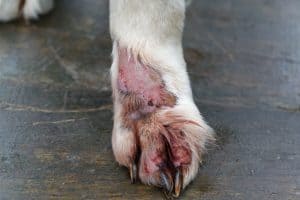How to recognize dog allergy and what you can do about it
Dog allergy is one of the most common health issues today, and it often goes unnoticed at first. Symptoms like itching, red skin, diarrhea, or ear infections are often not caused by fleas or infections, but by an overreacting immune system. Allergies don’t just go away on their own. If left untreated, they may affect multiple body systems and significantly reduce your dog’s quality of life.
Key things to know about dog allergy:
- how and why allergies develop,
- what types and symptoms to look for,
- and what you can do to support your dog – naturally and without side effects.
What causes a dog allergy?
A dog allergy is caused by the immune system overreacting to harmless substances like chicken, pollen, or dust mites. This leads to inflammation and symptoms such as itching, diarrhea, or ear infections.
Your dog’s body mistakenly identifies these substances as threats and launches an immune response. In fact, the real issue isn’t the allergen itself – it’s the immune system being out of balance.
Allergy or sensitivity?
Not every uncomfortable symptom means a true allergy. Many dogs experience digestive or skin issues caused by food sensitivities rather than immune reactions.
With food intolerance, your dog simply cannot digest certain ingredients properly – such as lactose or additives. This causes bloating or diarrhea, but it does not trigger an immune or inflammatory response.
In contrast, an allergy involves the immune system reacting to a harmless substance, such as chicken or pollen, as if it were dangerous. This immune response leads to inflammation and typical allergy symptoms.
The symptoms may look similar, but the underlying causes and treatment are completely different. That’s why it’s important to understand what’s really going on – only then can you give your dog the right support.
How to tell the difference between allergy and sensitivity?
The key difference is how the body reacts. A food sensitivity causes digestive issues without involving the immune system, while an allergy triggers an immune response that leads to inflammation and more serious symptoms.
If your dog has a sensitivity, symptoms like bloating or soft stools may appear. With an allergy, you may also see skin problems, itching, or ear infections. The treatment approach is different for each, so getting the diagnosis right is essential.
Dog allergy symptoms – what signs to look for?
Dog allergy symptoms can show up in different ways, depending on the allergen and how your dog’s body reacts. The most common signs include:
- Itching, red or irritated skin, and hair loss
- Ear infections, frequent head shaking, or ear scratching
- Digestive issues like diarrhea, bloating, or sensitivity
- Watery eyes or nose, sneezing, and nasal discharge
- Recurring skin infections or inflamed “hot spots”
- Excessive paw licking, chewing, or sore skin between the toes
These symptoms can also result from parasites, infections, or fungal issues. That’s why it’s essential to rule out other causes. Always consult a vet if the symptoms keep coming back or get worse over time.
Types of dog allergies
Dogs can suffer from different types of allergies, each with its own symptoms and triggers. Understanding the cause of your dog’s allergy is the first step to managing it effectively.
Skin allergy
- Itching, red or inflamed skin
- Hair loss, excessive scratching
- Chronic ear infections, head shaking
- Paw licking or chewing
These are only the most common signs. For a detailed guide on causes, symptoms, and treatment options, read our full article on dog skin allergies.
Food allergy
- Recurring diarrhea, bloating, or vomiting
- Skin irritation, itching, or hot spots
- Chronic ear problems
- Usually caused by specific proteins (e.g., chicken, beef, soy)
These symptoms often point to a food allergy. To learn more about common triggers, diagnosis, and effective management, see our in-depth article on dog food allergies.
Environmental allergy
- Seasonal or chronic symptoms
- Itchy paws, paw licking
- Watery eyes, sneezing, or fur loss
- Triggered by pollen, dust mites, mold, or chemicals
Autoimmune-like reactions
- Inflammation that responds poorly to steroids
- Persistent ear infections or open skin sores
- Can resemble allergies but require a different treatment approach
What triggers a dog allergy?
Several everyday substances can trigger allergic reactions in dogs. The most common dog allergy triggers include:
- Animal proteins – such as chicken, beef, eggs, or dairy
- Environmental allergens – including pollen, dust, and mold spores
- Fleas – especially allergic reactions to flea saliva
- Household chemicals – like cleaning agents or laundry detergents
- Contact materials – such as synthetic bedding, rubber toys, or plastic bowls
Allergy symptoms may worsen with repeated exposure or seasonal changes. Genetic predisposition and gut health also play a role in sensitivity.
How can you identify the real cause of your dog’s allergy?
The only reliable method to identify food allergies is an elimination diet. This involves feeding your dog a simplified diet for at least 6-8 weeks, using novel protein and carbohydrate sources.
If symptoms improve during this period and return when the original food is reintroduced, it’s likely a food allergy. For environmental allergies, intradermal or blood tests may help identify specific triggers.
At-home observations are also important. Keeping a symptom diary, noting seasonal patterns, or testing different shampoos can help narrow down the cause.
Common myths about dog allergy
- “Allergies only cause skin symptoms.” False – digestive, respiratory, and behavioral symptoms can also appear.
- “If the food is hypoallergenic, it can’t cause allergies.” Not true – any protein can become an allergen over time.
- “Antihistamines always solve the problem.” They may provide relief, but they don’t address the underlying immune imbalance.
How to support a dog with allergies naturally?
How can you help your dog with allergies naturally? Focus on immune balance, gut health, and anti-inflammatory support. Ingredients like colostrum, medicinal mushrooms, and zinc offer gentle, effective relief without the side effects of steroids or antihistamines.
Key natural ingredients that can help
- Colostrum – helps recalibrate the immune system, reduce excessive immune responses, support gut flora, and speed up tissue regeneration.
- Reishi (Ganoderma lucidum) – an anti-inflammatory and immune-modulating mushroom that supports both environmental and autoimmune-related allergies.
- Agaricus blazei – a powerful immune stimulant, often used to help with skin inflammation and digestive sensitivities.
- Poria cocos – supports digestive health, helps restore the intestinal lining, and contributes to gut flora balance.
- Zinc – an essential mineral for healthy skin and coat; may help reduce itching and inflammation.
These ingredients are often found in natural dog allergy medicine products, designed to relieve symptoms while strengthening the immune system long-term.
Summary – every allergic dog deserves relief
Dog allergy is not just a minor inconvenience – it’s a complex immune imbalance that needs targeted, long-term support. Don’t just mask the symptoms. Look for solutions that work with your dog’s natural systems to restore balance and comfort.
Looking for information on kutya allergia magyarul? Click here to read more. If you’d like to do even more for your dog’s health, we recommend reading our articles on krill oil and omega-3 for dogs – these natural nutrients can help reduce inflammation and support the immune system. For senior dogs, our guide on immune support for older dogs is especially valuable. If you’re looking for trustworthy information about cancer, don’t miss our articles on lymphoma in dogs and types of dog tumors. You might also enjoy learning more about dog sports and how to build a healthier diet that improves your dog’s wellbeing and resilience.
References:
- Verlinden et al. (2006): Food allergy in dogs and cats
- Olivry et al. (2010): Canine atopic dermatitis
- Marsella et al. (2011): Skin barrier dysfunction in canine atopic dermatitis
- Vetvicka & Vetvickova (2011): Immune enhancing effects of β-glucan in dogs
- Pakkanen & Aalto (1997): Growth factors and antimicrobial factors of bovine colostrum
- NIH (2024): Zinc






